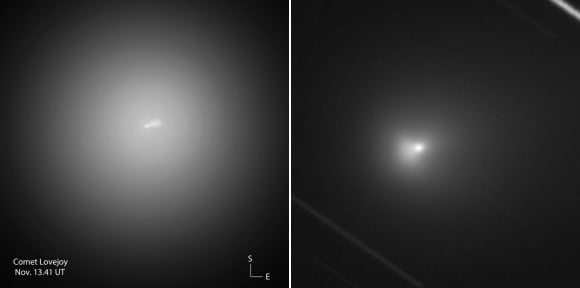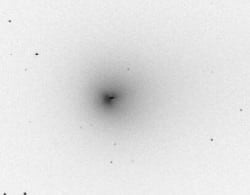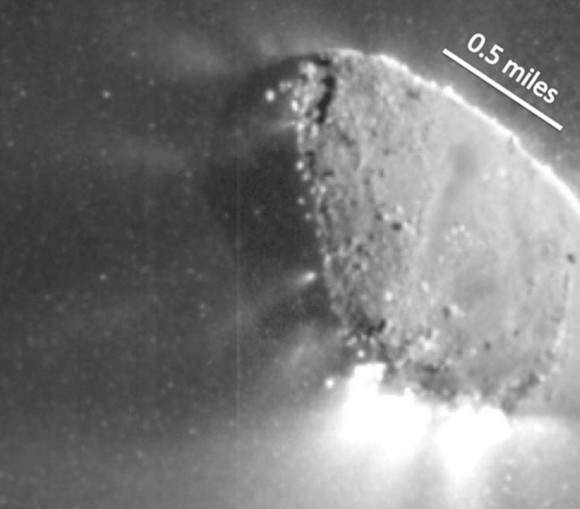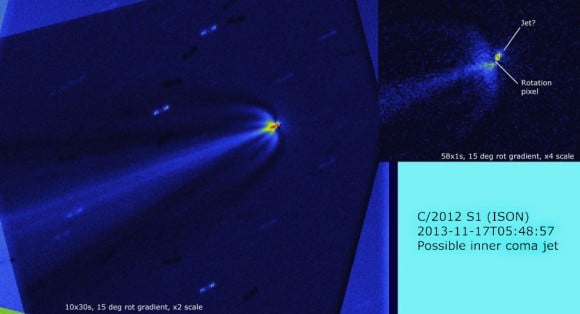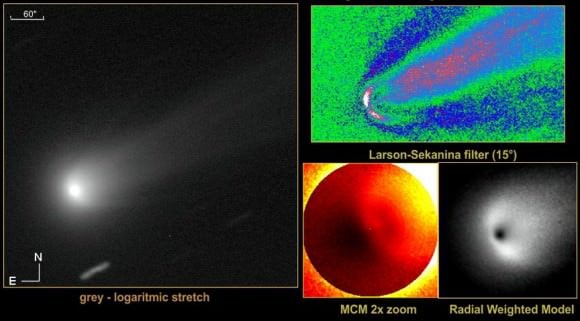Wonderful photos of Comets ISON and Lovejoy with their swollen comas and developing tails have appeared on these pages, but recently, amateur and professional astronomers have probed deeper to discover fascinating dust structures emanating from their very cores. Most comets possess a fuzzy, starlike pseudo-nucleus glowing near the center of the coma. Hidden within this minute luminous cocoon of haze and gas lies the true comet nucleus, a dark, icy body that typically spans from a few to 10 kilometers wide. Comet ISON's nucleus could be as large as several kilometers and hefty enough (we hope!) to survive its close call with the sun on Nov. 28.
[caption id="attachment_106485" align="aligncenter" width="580"]
Sketch using Photoshop of the inner region of Comet Lovejoy's coma showing the false nucleus and the curious dust fountain observed on Nov. 13 in a 15-inch (37-cm) telescope. Credit: Bob King. At right the same plume photographed on Nov. 12 with north up and east to the left. Credit: Luc Arnold[/caption]
Last Wednesday morning Nov. 13 when calm air allowed a sharp view inside Comet Lovejoy's large, 15-arc-minute-wide coma I noticed something odd about the false nucleus at low magnification, so I upped the power to 287x for a closer look. Extending from the fuzzy core in the sunward direction was a small cone or fountain-shaped structure of denser, brighter dust shaped like a miniature comet. It stretched eastward from the center and wrapped slightly to the south. Usually it's harder than heck to see any details within the fuzzy, low-contrast environment of a comet's coma unless that comet is close to Earth and actively spewing dust and ice. Lovejoy scored on both.
[caption id="attachment_106481" align="alignleft" width="250"]
Negative image taken Nov. 14 of Lovejoy's nucleus and dust fan. North up, west to the right. Credit: Dr. P. Clay Sherrod[/caption]
By good fortune,
Dr. P. Clay Sherrod
of the Arkansas Sky Observatories, USA, and
Luc Arnold
of Saint-Michel-l'Observatoire, France, shared images they'd made at high magnification of the identical feature right at the same time as my own observation. There's no doubt that what we saw was a
jet
or combined jets of dust and vapor blasting from Lovejoy's true nucleus. Jets are linear or fan-shaped features and carry ice, dust and even snowballs from inside the nucleus out into space. They typically form where freshly-exposed ice from breaks or fissures in the comet's crust vaporizes in the sun's heat.
What I wouldn't give to see one up close. Wait - we can. Take a look at the photo of
made during NASA's EPOXI flyby mission in November 2010. Notice that most of Hartley's crust appears intact with the jets being the main contributors to the dust and gas that form the coma and tail.
[caption id="attachment_106482" align="alignnone" width="580"]
Multiple jets were actively spewing ice and dust when NASA's EPOXI mission zoomed by Comet Hartley 2 in November 2010. The fuzzy spots are balls of fluffy snowballs measuring between 1 inch and 1 foot across. Credit: NASA[/caption]
Spotting a jet usually requires good seeing (low atmospheric turbulence) and high magnification. They're low-contrast features but worth searching for in any bright comet. Jets often point toward the sun for good reason - the sunward side of the comet is where the heating is happening. Activity dies back as the comet rotates to face away from the sun during the night and early morning hours. By studying the material streaming away from a comet via jets, astronomers can determine the rotation period of the nucleus.
[caption id="attachment_106483" align="alignright" width="201"]
Nightly images of Comet Hale-Bopp's rotating nucleus and spiraling jet made March 24-30, 1997 by Brad D. Wallis of JPL. The photos were assembled into this animation by Sky & Telescope[/caption]
Sometimes material sprayed by jets expands into a curved parabolic hood within the coma. This may explain the wing-shaped structures poking out from Comet ISON's coma seen in recent photos. Possibly the Nov. 13-14 outburst released a great deal of fresh dust that's now being pushed back toward the tail by the ever-increasing pressure of sunlight as the comet approaches perihelion.
The inner coma of
Comet Hale-Bopp
developed a striking series of hoods in March 1997 when a dust jet spewed material night after night from the comet's rotating nucleus. The animation captures garden sprinkler effect beautifully. Since the nucleus spun around every 11 hours 46 minutes, multiple spiraling waves passed through the coma in the sunward direction. To the delight of amateur astronomers at the time, they were plainly visible through the telescope.
[caption id="attachment_106487" align="aligncenter" width="580"]
Processed images showing a possible jet extending southeast (PA 150 degrees) of Comet ISON's nucleus as well as the new wing-like hoods on Nov. 17, 2013. Credit: Denis Buczynski and Nick James of the BAA[/caption]
When examining a comet, I start at low magnification and note coma shape, compactness and color as well as tail form and length and details like the presence of streamers or knots. Then I crank up the power and carefully study the area around the nucleus. Surprises may await your careful gaze. If Comet ISON does break up, the first sign of it happening might be an elongation or stretching of the false nucleus. If it's no longer a small, star-like disk or if you notice a fainter, second nucleus tailward of the main, the comet's days may be numbered.
[caption id="attachment_106486" align="aligncenter" width="580"]
Another view of the symmetrical "wings" photographed branching from Comet ISON's coma on Nov. 15. At right, the photo has been specially processed to show the structure more clearly. Credit: Erik Bryssinck[/caption]
 Universe Today
Universe Today

